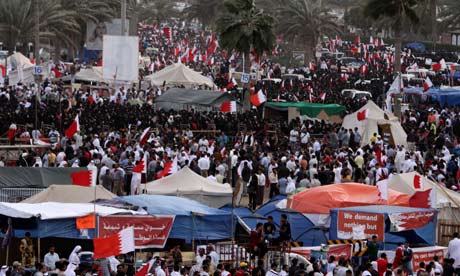Bahrain's regime has driven a wedge between Sunnis and Shias with its denial of civil rights and promotion of economic disparity

Describing a pro-government demonstration in Bahrain last week, Michael Slackman wrote in the New York Times that it was an affluent crowd, very different from the mostly low-income Shia who were protesting against the government. "The air was scented with perfume, and people drove expensive cars," he said.
While local and international media talk repeatedly about Bahrain's sectarian divide, demonstrators on both sides insist there is Shia-Sunni unity. So what, exactly, is going on?
First, some facts. The majority of Bahrainis – about 70% – are Shia, and the majority of pro-reform/anti-government demonstrators at the Pearl Roundabout are Shia. It is true, also, that Bahrain is ruled by a Sunni royal family, and that the majority of participants at pro-government rallies appear to be Sunnis.
This is not to say that all Bahraini Sunnis are rich or that being Shia is always synonymous with being poor. As many commentators will point out, Bahrain is home to economically powerful Shia families and high-ranking Shia government officials.
But the facts of the matter speak for themselves. Corruption, crony capitalism and a lack of transparency add up to uneven development and a vast disparity in wealth. By and large, Bahrain's Shia are losing out in the country's economic boom.
What this reflects, to a large extent, is the success of the Bahraini regime's strategy to deal with challenges to its legitimacy by promoting and reinforcing identity politics within a system of privileges where certain groups and individuals are favoured over others. In a word: discrimination.
So the Shia represent the majority of pro-reform, anti-government protesters because they are the majority of the population, but also because the government actively discriminates against them.
Meanwhile, Bahrain's rulers, the majority of the government, military, and business leaders are Sunni. Bahrain's political, social and economic system operates by offering privileges and wasta to some, at the expense of the rights of others. In this way, the government maintains a separation between Bahrain's communal groups (Baharna, Arab, Howala, Ajam, Asians) and discourages citizens from associating with each other on a national basis – which has posed a real challenge to the regime in the past.
This "divide and rule" policy was developed by the Al Khalifa and its allies after they settled in Bahrain in the 18th century, appropriated land from the indigenous Shia owners and effectively made them into peasants. Even then, the regime operated with the assistance of a number of Shia families who it employed as ministers or tax collectors. Still today, high-ranking government positions are disproportionately awarded to members of the Al Khalifa family, or other Sunni allies, and a few handpicked Shia representatives are given positions of power.
Continuing a discriminatory tradition set by imperial Britain during Bahrain's time as a British protectorate (when police were recruited from British-colonised India), the regime today relies on defence from imported mercenaries, while Bahraini Shia are denied the right to serve in their own armed forces.
Another form of discrimination is electoral gerrymandering. In past elections, the Shia-dominated northern governorate of more than 91,000 voters elected nine members of parliament. In the Sunni-dominated southern governorate only 16,000 voters elected six members.
This is in addition to the detention of hundreds of Shia protesters last year, and the arrest of 23 Shia citizens charged with forming a "terror network" to overthrow the government. The 23 – many of them members of the Haq Movement of Liberties and Democracy (an opposition group that boycotts elections) – were charged under the widely criticised anti-terror law. They were eventually released last week in a concession to the current uprising, confirming suspicions that the case was politically motivated.
Bahrain's sectarian divide therefore stems from economic disparity and the denial of civil rights.
A better way to understand the current uprising is as a movement for civil rights and liberties. The demands are for transition from a system of privileges for a few at the expense of the many towards a system of greater rights for all. That is presumably why the Shia-dominated "cannot-haves" of the anti-government, pro-reform crowds appear to have crossed the sectarian rift and drawn in Bahrainis from a range of political platforms including liberals, secularists and human rights activists.
This is not to say that there are no sectarian elements within both the anti-government camp and the pro-government rallies. But at this point there appears to be a broader call for less economic disparity and more rights, which has to some extent managed to cut through the religious boundaries. A good illustration of the class element is the position of the affluent upper-middle class "Nido" youth. While some are part of the Pearl Roundabout pro-reform opposition, many more have woken from their apolitical reverie to support the pro-government movement, complaining that the protesters do not represent "the Bahrain we know" – and of course they don't.
In terms of conciliatory gestures by the government, what Bahrain needs now is not publicity stunts by the government and its privileged supporters proclaiming "unity". This is little more than a PR exercise to sideline the issue of a deeply flawed and potentially failing political system.
It has been a long winter of discontent in the wider Middle East; and the sweeping changes this spring have not escaped Bahrain's imagination. The outcome right now looks uncertain, but one thing is sure: it is not the demands of the pro-reform protesters at Pearl Roundabout but the Bahrain government's rule by repression and discrimination that is pushing this country towards a "sectarian abyss".

No comments:
Post a Comment